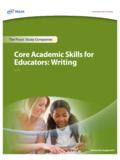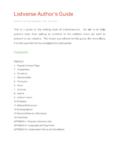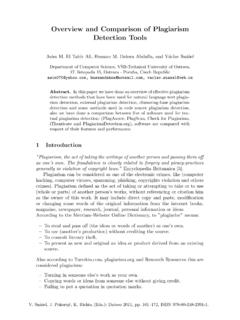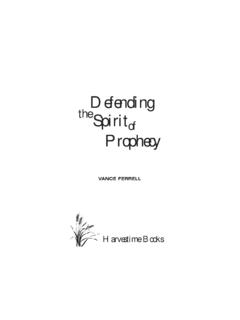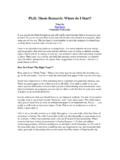Transcription of academicintegrity.curtin.edu.au ACADEMIC INTEGRITY
1 ACADEMIC INTEGRITYSTUDENT GUIDELINES FOR AVOIDING PLAGIARISMAT PDF version of this booklet is also available online at: Curtin University 2015 This publication is copyright. Apart from any fair dealing for the purposes of private study, research, criticism or review, as permitted under the Copyright Act 1968, no part may be reproduced by any persons without written by Curtin Teaching and Learning, Curtin UniversityFirst published 2006 (Edited by Shelley Yeo and Robyn Chien) Reprinted 2009 (Edited by Jonathan Yorke and Lisa Winter) Reprinted 2010 (Edited by Jonathan Yorke, Lisa Winter, Shelley Kinsella and Connie Price) Reprinted 2011 (Edited by Jonathan Yorke, Shelley Kinsella and Connie Price) Reprinted 2013 (Edited by Connie Price and Karen Glaister)Reprinted 2015 (Edited by Connie Price and Jon Yorke)Curtin University CRICOS Provider code 00301J Curtin Sydney CRICOS Provider code 02637 BPrinted in Australia by Daniels Printing Craftsmen Design and art direction by Curtin Teaching and LearningCurtin Teaching and Learning Bentley CampusStreet Address.
2 Kent Street Bentley WA 6102 Postal Address: GPO Box U1987 Perth WA 6845 Tel: (08) 9266 1000 Web: TO KNOW ABOUT ACADEMIC INTEGRITY ? Breaching ACADEMIC INTEGRITY .. Definitions and terms ..32. WHAT IS plagiarism ? What is self- plagiarism ? .. What is collusion? .. What is contract cheating? .. What if I did not mean to plagiarise? .. What if others around me plagiarise? .. Levels of plagiarism at Curtin ..73. WHAT CAN I DO TO AVOID plagiarism IN MY WORK? What ACADEMIC writing conventions do I need to understand? .. Referencing .. Quoting .. Paraphrasing .. How can I avoid plagiarising when I work with other students? .. Can I use my own work? .. Can I use an editor? .. Where can I get more advice/help? .. Courses and resources .. English assistance .. plagiarism Checklist ..154. HOW CAN TURNITIN HELP? 175. WHAT COULD HAPPEN IF I AM ACCUSED OF plagiarism ? Penalties for plagiarism at Curtin.
3 Can I appeal? ..216. A GLOSSARY OF COMMON TERMS 227. REFERENCES 2621. WHY DO I NEED TO KNOW ABOUT ACADEMIC INTEGRITY ?Curtin Values and ACADEMIC IntegrityIntegrity: honesty, trust and fairnessAcademic honesty underpins respect for knowlege and its development. ACADEMIC staff must be honest in their research and in their dealings with other staff and with students. Students must be honest with themselves and others, in their personal ambition, study and in their involvement in the assessment follows ACADEMIC honesty. Society trusts an ACADEMIC institution which, through its mission, public work and in how it deals with employees and students, demonstrates commitment to ACADEMIC INTEGRITY . Staff trust the institution to uphold honest scholarly enterprise. Students trust their lecturers to guide their learning and to uphold the values to which the institution aspires. ACADEMIC staff trust students to work honestly, and with effort, to achieve their personal in an ACADEMIC community expects to be treated fairly.
4 Fairness is expressed in the institution s standards, practices and procedures, and in all interactions between the institution, its staff and its students. Judgements about the work of staff must be fair and accountable. Assessment of the work and learning of students must be fair and : Respect comes from meeting high and honourable expectations. Society has respect for an ACADEMIC institution that is seen to uphold high standards of conduct in learning, teaching and research. Respect among those in an ACADEMIC community means interacting with civility and justice, and valuing others and their work. Self respect comes from active and honest involvement in the learning and ACADEMIC : Those in an ACADEMIC community have the right to expect that the principles of ACADEMIC INTEGRITY and scholarship will be upheld. However, with rights come responsibilities. Responsibility for ACADEMIC INTEGRITY and scholarship thus rests with every member of the community.
5 This sometimes requires us to have the courage to challenge the actions of others and to take specific actions to ensure that ACADEMIC INTEGRITY is and Impact: By upholding the principles of ACADEMIC INTEGRITY the members of our ACADEMIC community are inspired and enabled to achieve excellence. With trust, it becomes possible for our work to have impact.(adapted from The fundamental values of ACADEMIC INTEGRITY The Center for ACADEMIC INTEGRITY , 1999).When you enrolled at Curtin University you entered a community which upholds five core values: INTEGRITY , respect, courage, excellence, and impact. ( )These values align with long-standing principles of ACADEMIC INTEGRITY described by The Centre for ACADEMIC INTEGRITY (1999).A Curtin degree has prestige in the wider community because of the commitment made to the principles of ACADEMIC INTEGRITY . Future employers can be assured that Curtin promotes ACADEMIC INTEGRITY and expects students to behave honestly in the pursuit of their studies whilst taking responsibility for the INTEGRITY of their a student you are a member of this community and you are asked to work to uphold the principles of ACADEMIC INTEGRITY during your course of study.
6 Curtin s Student Charter sets out the expectations and responsibilities of students; specifically it states Students also have responsibilities and are expected to: .. recognise that cheating, plagiarism and fabrication or falsification of data are not acceptable ( Student Charter , 2011, ) BREACHING ACADEMIC INTEGRITYT here are a number of ways in which students may breach ACADEMIC INTEGRITY , including cheating, interfering with the learning of others and plagiarising. Depending on the type and extent of the breach of ACADEMIC INTEGRITY it may constitute ACADEMIC misconduct. Curtin takes ACADEMIC misconduct seriously and there are penalties for students found guilty of ACADEMIC university, students are expected to demonstrate their own understanding and thinking using the information or ideas provided by others to support and inform their work, whilst making due acknowledgement to the source.
7 There are prescribed ACADEMIC conventions students must learn and use to avoid plagiarising the work of others. This booklet is about plagiarism . It describes what plagiarism is, shows you how to appropriately use and acknowledge the work and information provided by others, and indicates what you can expect to happen if you do plagiarise. For information about other breaches of ACADEMIC INTEGRITY , including ACADEMIC and general misconduct, refer to Statute 10 - Student Discipline ( ). DEFINITIONS AND TERMSMany of the terms used in this booklet need explanation. Do you know the meaning of the highlighted words in the following passage?The definition and examples of plagiarism provided in this booklet indicate that closely paraphrasing sentences, paragraphs or ideas is considered plagiarism . The use of other people s ideas without appropriate acknowledgement is considered to be plagiarism . You will need to learn how to paraphrase well and remember that even if you have paraphrased, you will still need to acknowledge the source by using a citation.
8 In order to acknowledge the work appropriately you need to know how to use in-text citations based on the referencing style suitable for your discipline. Some of you will need to spend some time learning scholarly writing skills, particularly in the use of citations and paraphrasing. These skills will not necessarily be addressed in your course work but will be expected to be demonstrated in all ACADEMIC work glossary of common terms, provided in Section 6, explains these and other terms that are referred to in this WHAT IS plagiarism ? plagiarism means presenting the work or property of another person as one s own, without appropriate acknowledgement of their work. There are many different ways that plagiarism can happen and you should be aware of these. Consider the descriptions below of different ways that plagiarism can of PlagiarismExplanationOriginality of workToo closely paraphrasing sentences, paragraphs or ideas, copying sentences and substituting words with similar meaning.
9 When paraphrasing from a source, the meaning of the sentence or paragraph should be expressed in your own words without copying either the words or the structure of the sentence/paragraph. See Section 3 for more on your own previously submitted or assessed work without permission or acknowledgement. Submitting your own previously submitted or published work for publication elsewhere without permission or acknowledgement. This is known as you have submitted ACADEMIC work for assessment or credit, it is considered dishonest to then submit the same work for further credit elsewhere. See Section 3 for more on avoiding written or creative work which has been produced by someone else and claiming authorship for it, including: reproducing all or parts of another student s work (including students who have previously completed the same unit) allowing another person to do the work for you contracting another person to do the work for you purchasing work from another is dishonest to ask, arrange for or pay someone to do work for you that you will later claim or present as your own.
10 This applies to the use or purchase of material from websites or anyone offering ACADEMIC writing or contracting another person to edit and substantially change your you ask someone to edit or proofread your work make sure that person only highlights or indicates where there are problems rather than fixing the problem or changing the text or work for you employ an editor to assist you with the production of your assignment or thesis you should include an acknowledgement indicating that an editor was used and provide a description of the scope of the Section 3 for more on avoiding plagiarism from editorial of PlagiarismExplanationAcknowledgement of workCopying/using words, sentences or paragraphs which are the work of other persons without due acknowledgement. This includes copying from: published works books, articles, theses or reports unpublished works, assignments, letters/memos/personal communications (including e-mails), and raw data seminar and conference papers teaching material, including lecture notes web site content, material published on or sourced from the another person s creative work without due acknowledgement.
